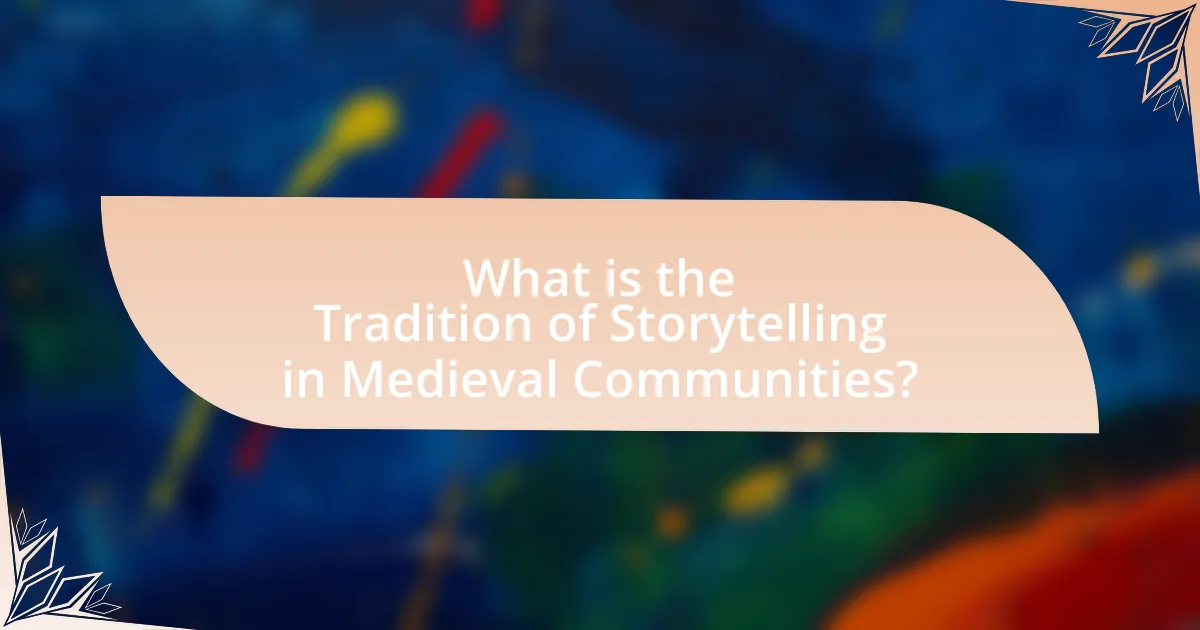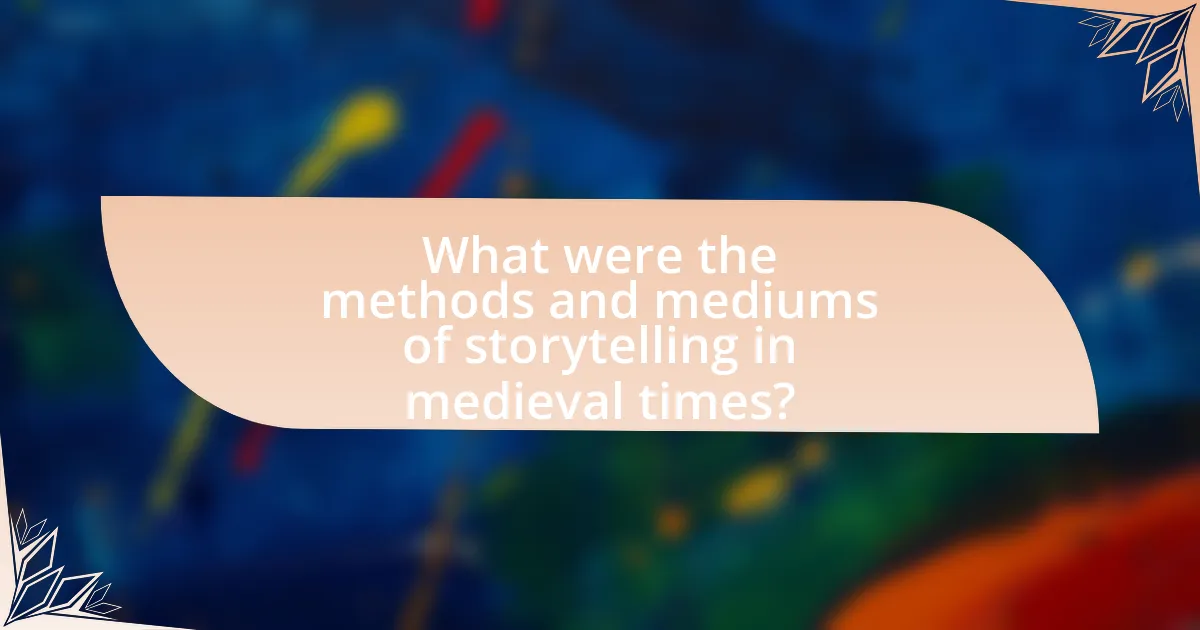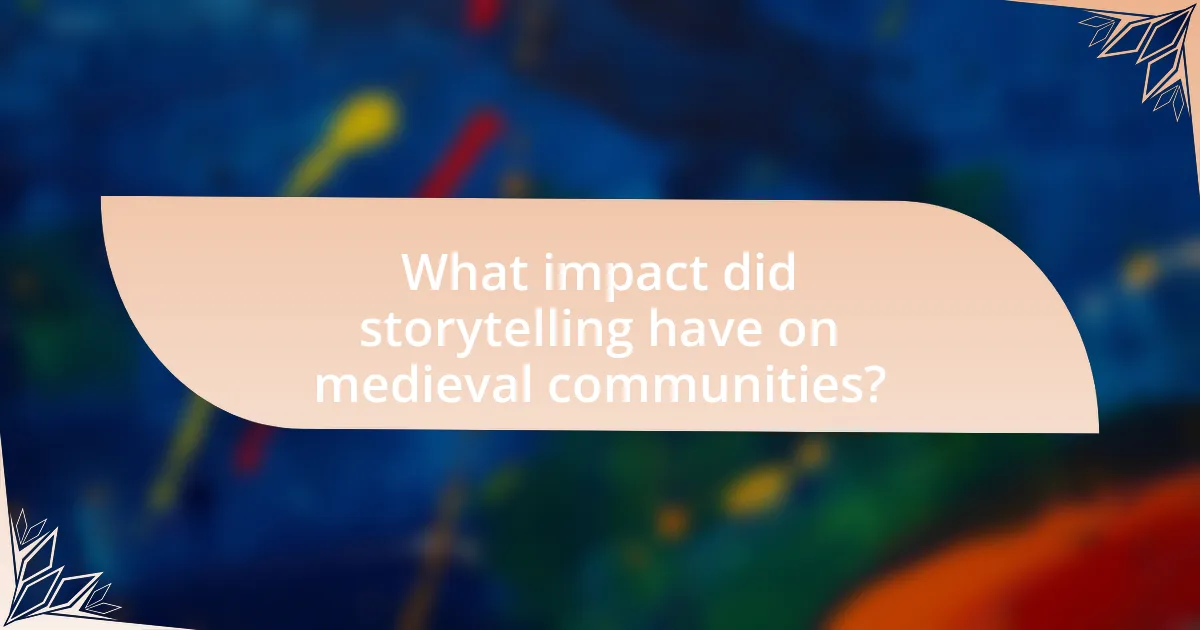The tradition of storytelling in medieval communities was a crucial method for preserving culture, history, and moral lessons. Storytellers, often known as bards or minstrels, played a significant role in fostering community identity and social cohesion through oral narratives shared during public gatherings. These stories encompassed themes of adventure, romance, and morality, reflecting societal norms and values. The article explores the functions of storytelling, the roles of storytellers, the impact on community bonding, and the methods used to convey these narratives, highlighting the importance of storytelling in shaping medieval culture and its lasting legacy on modern literature and community practices.

What is the Tradition of Storytelling in Medieval Communities?
The tradition of storytelling in medieval communities served as a vital means of preserving culture, history, and moral lessons. Storytellers, often referred to as bards or minstrels, would gather audiences in public spaces, sharing tales that ranged from folklore to historical events, thereby fostering a sense of community and shared identity. This oral tradition was essential in an era when literacy rates were low, and written records were scarce, making storytelling a primary method for transmitting knowledge and values across generations. Historical evidence shows that these narratives often included elements of adventure, romance, and morality, reflecting the societal norms and beliefs of the time.
How did storytelling function within these communities?
Storytelling functioned as a vital means of cultural transmission and social cohesion within medieval communities. It served to preserve history, convey moral lessons, and reinforce community values through oral narratives shared during gatherings. These stories often included local legends, historical events, and moral tales that reflected the community’s identity and beliefs, thereby fostering a sense of belonging among members. Historical records indicate that storytelling was integral to communal events, such as feasts and festivals, where it facilitated interaction and strengthened social bonds.
What roles did storytellers play in medieval society?
Storytellers in medieval society served as vital cultural figures who preserved history, entertained audiences, and conveyed moral lessons. They acted as oral historians, recounting tales of heroes, battles, and local legends, which helped to maintain a sense of community identity and continuity. Additionally, storytellers often performed in public spaces, such as marketplaces and courts, engaging listeners and fostering social cohesion through shared narratives. Their stories frequently contained moral or ethical teachings, reflecting societal values and norms, thus playing a crucial role in education and moral instruction. Historical records indicate that these performances were integral to community gatherings, highlighting the storytellers’ importance in both entertainment and the transmission of cultural knowledge.
How did storytelling contribute to community bonding?
Storytelling contributed to community bonding by fostering shared experiences and cultural identity among members of medieval communities. Through oral narratives, individuals conveyed values, traditions, and collective histories, which reinforced social cohesion. For example, communal gatherings often featured storytelling sessions where tales of heroism, morality, and local legends were shared, creating a sense of belonging and mutual understanding. This practice not only entertained but also educated community members, ensuring that cultural knowledge was passed down through generations, thus strengthening the ties that bind the community together.
Why was storytelling important in medieval culture?
Storytelling was important in medieval culture because it served as a primary means of preserving history, imparting moral lessons, and fostering community cohesion. In an era where literacy rates were low, oral narratives allowed for the transmission of cultural values and historical events, ensuring that knowledge was passed down through generations. For instance, epic tales like “Beowulf” not only entertained but also reinforced societal norms and heroic ideals. Additionally, storytelling facilitated social gatherings, strengthening bonds among community members and providing a shared identity. This cultural practice was essential for maintaining traditions and collective memory in medieval societies.
What themes were commonly explored in medieval stories?
Common themes explored in medieval stories include chivalry, religion, love, and morality. Chivalry often depicted the ideals of knightly behavior, emphasizing bravery and honor, as seen in tales like “Sir Gawain and the Green Knight.” Religion played a significant role, with many stories reflecting Christian values and teachings, such as in “The Divine Comedy” by Dante Alighieri. Love, both romantic and platonic, was a prevalent theme, illustrated in works like “The Canterbury Tales” by Geoffrey Chaucer. Morality was frequently examined through allegorical narratives, where characters faced moral dilemmas, as seen in “Everyman.” These themes were integral to the cultural and social fabric of medieval communities, shaping their storytelling traditions.
How did storytelling preserve history and traditions?
Storytelling preserved history and traditions by serving as a primary method for transmitting cultural knowledge across generations. In medieval communities, oral narratives encapsulated significant events, moral lessons, and societal values, ensuring that collective memory was maintained. For instance, epic tales like “Beowulf” not only entertained but also conveyed the history and heroic ideals of the Anglo-Saxon culture, reinforcing social norms and communal identity. This oral tradition was crucial in an era with limited written records, as it allowed communities to remember their past and pass down customs, rituals, and beliefs, thereby solidifying their cultural heritage.

What were the methods and mediums of storytelling in medieval times?
The methods and mediums of storytelling in medieval times included oral traditions, written texts, and visual arts. Oral storytelling was prevalent, with bards and minstrels reciting tales in public spaces, often accompanied by music, which helped to preserve cultural narratives. Written texts, such as illuminated manuscripts and religious texts, became important as literacy increased, allowing stories to be documented and shared more widely. Additionally, visual arts, including tapestries and stained glass, depicted stories and biblical narratives, serving as a medium for storytelling in churches and public spaces. These methods and mediums collectively contributed to the rich tapestry of storytelling in medieval communities, reflecting their values and beliefs.
How were stories shared among community members?
Stories were shared among community members through oral traditions, gatherings, and communal events. In medieval communities, storytelling often occurred during festivals, religious ceremonies, and social gatherings, where individuals would recount tales to entertain and educate others. This practice was essential for preserving cultural heritage, as many stories conveyed moral lessons, historical events, and communal values, ensuring that knowledge was passed down through generations. The oral nature of storytelling allowed for dynamic interactions, with listeners engaging and contributing to the narrative, thus reinforcing community bonds and shared identity.
What types of gatherings facilitated storytelling?
Types of gatherings that facilitated storytelling in medieval communities included feasts, festivals, and communal gatherings. These events provided a social context where individuals could share tales, legends, and folklore, often accompanied by music and performance. Historical records indicate that during these gatherings, oral traditions were preserved and passed down, reinforcing community bonds and cultural identity. For instance, the medieval feast was a significant occasion for storytelling, as it brought together diverse members of the community, allowing for the exchange of narratives that reflected shared experiences and values.
How did oral traditions differ from written narratives?
Oral traditions differ from written narratives primarily in their method of transmission and preservation. Oral traditions rely on spoken word and memory, allowing stories to evolve with each retelling, while written narratives are fixed texts that preserve the original content and structure. Historical evidence shows that oral traditions were prevalent in medieval communities, where storytelling was a communal activity, often performed in gatherings, whereas written narratives emerged later with the advent of literacy and the printing press, providing a stable record of stories. This distinction highlights the dynamic nature of oral storytelling compared to the static nature of written accounts.
What tools and techniques enhanced storytelling?
Tools and techniques that enhanced storytelling in medieval communities included oral traditions, visual aids, and performance elements. Oral traditions allowed stories to be passed down through generations, ensuring cultural continuity and community engagement. Visual aids, such as illuminated manuscripts and tapestries, provided a visual context that enriched the narrative experience. Performance elements, including music, gestures, and dramatic readings, captivated audiences and made stories more memorable. These methods collectively fostered a vibrant storytelling culture that was integral to the social fabric of medieval life.
How did music and performance influence storytelling?
Music and performance significantly influenced storytelling by enhancing emotional engagement and aiding memory retention. In medieval communities, bards and minstrels used musical elements and dramatic presentations to captivate audiences, making stories more memorable and impactful. Historical evidence shows that oral traditions relied on rhythmic patterns and melodies, which helped storytellers convey complex narratives and evoke specific emotions, thereby enriching the storytelling experience. This integration of music and performance not only entertained but also reinforced cultural values and communal identity through shared narratives.
What role did visual aids play in storytelling?
Visual aids played a crucial role in storytelling by enhancing comprehension and engagement among audiences in medieval communities. These aids, such as illustrations, tapestries, and illuminated manuscripts, provided visual context that complemented oral narratives, making complex stories more accessible. Historical evidence shows that visual representations helped convey themes and emotions, allowing listeners to connect more deeply with the tale being told. For instance, illuminated manuscripts often depicted scenes from religious texts, aiding in the understanding of moral lessons and cultural values prevalent during that time.

What impact did storytelling have on medieval communities?
Storytelling significantly impacted medieval communities by serving as a primary means of preserving culture and history. It facilitated the transmission of values, traditions, and collective memory, often through oral narratives that conveyed moral lessons and historical events. For instance, epic tales like “Beowulf” not only entertained but also reinforced social norms and community identity. Additionally, storytelling fostered social cohesion by bringing people together in communal gatherings, where shared narratives strengthened bonds among individuals. This communal aspect is evidenced by the prevalence of storytelling in public spaces, such as marketplaces and festivals, where diverse groups engaged with the same stories, enhancing a sense of belonging and unity within the community.
How did storytelling influence social norms and values?
Storytelling significantly influenced social norms and values by serving as a medium for the transmission of cultural beliefs and ethical standards within medieval communities. Through narratives, communities conveyed lessons about morality, social roles, and acceptable behaviors, reinforcing collective identity and shared values. For instance, tales of chivalry and heroism not only entertained but also established ideals of bravery and honor, shaping the expectations of individuals in society. Historical evidence shows that oral traditions, such as those found in the works of Geoffrey Chaucer, reflected and reinforced the social hierarchies and moral codes of the time, illustrating how storytelling was integral to the maintenance of social order and cultural continuity.
What moral lessons were commonly conveyed through stories?
Moral lessons commonly conveyed through stories include the importance of honesty, the value of kindness, and the consequences of greed. In medieval storytelling, narratives often illustrated these themes through characters and their experiences, reinforcing societal values. For instance, tales like “The Pardoner’s Tale” from Geoffrey Chaucer’s “The Canterbury Tales” explicitly demonstrate the dangers of greed and the moral that it leads to one’s downfall. Additionally, fables such as those attributed to Aesop, which were popular in medieval times, frequently highlighted virtues like honesty and kindness, teaching audiences about ethical behavior through simple yet impactful narratives. These stories served as moral guides, shaping the ethical framework of medieval communities.
How did storytelling shape community identity?
Storytelling shaped community identity by serving as a means of preserving cultural values, shared history, and collective memory among medieval communities. Through oral narratives, communities transmitted important lessons, moral codes, and historical events, which reinforced social cohesion and a sense of belonging. For instance, tales of local heroes or significant events fostered pride and unity, while also distinguishing one community from another. This practice was essential in an era where written records were scarce, making storytelling a vital tool for maintaining the community’s identity and continuity across generations.
What legacy has the tradition of storytelling left behind?
The tradition of storytelling has left behind a rich legacy of cultural preservation and communal identity. Storytelling served as a vital means of transmitting history, values, and social norms within medieval communities, ensuring that collective memories and traditions were passed down through generations. For instance, oral narratives often included moral lessons and historical events, which helped to shape the identity of communities and foster a sense of belonging. This practice not only reinforced social cohesion but also contributed to the development of literature and the arts, influencing later written works and cultural expressions.
How has medieval storytelling influenced modern literature?
Medieval storytelling has significantly influenced modern literature by establishing narrative structures, themes, and character archetypes that persist today. The use of quests, moral lessons, and the interplay of good versus evil in medieval tales, such as those found in Arthurian legends, laid the groundwork for contemporary storytelling techniques. Additionally, the oral tradition of storytelling in medieval communities emphasized the importance of audience engagement and the use of vivid imagery, which are essential elements in modern narrative forms. This influence is evident in the works of authors like J.R.R. Tolkien and C.S. Lewis, who drew inspiration from medieval texts to craft their own rich, imaginative worlds.
What can contemporary communities learn from medieval storytelling practices?
Contemporary communities can learn the importance of oral tradition and community engagement from medieval storytelling practices. In medieval times, storytelling served as a vital means of preserving history, culture, and moral lessons, fostering a sense of identity and belonging among community members. This practice encouraged active participation, as audiences were not merely passive listeners but often engaged with the storyteller, creating a shared experience that strengthened social bonds. Historical evidence shows that storytelling was a communal activity, often held in public spaces, which facilitated dialogue and collective memory, essential for community cohesion. By adopting similar practices today, contemporary communities can enhance social connections and cultural continuity.
What are some best practices for preserving storytelling traditions today?
To preserve storytelling traditions today, communities should actively engage in oral storytelling events, utilize digital platforms for sharing stories, and encourage intergenerational storytelling. Oral storytelling events, such as community gatherings or festivals, allow for live performances that keep the tradition vibrant and accessible. Digital platforms, including social media and podcasts, enable wider dissemination of stories, reaching diverse audiences and preserving them for future generations. Encouraging intergenerational storytelling fosters connections between young and old, ensuring that traditional narratives are passed down and adapted over time. These practices are supported by research indicating that oral traditions are vital for cultural identity and community cohesion, as highlighted in studies by the Smithsonian Institution on the importance of storytelling in cultural preservation.